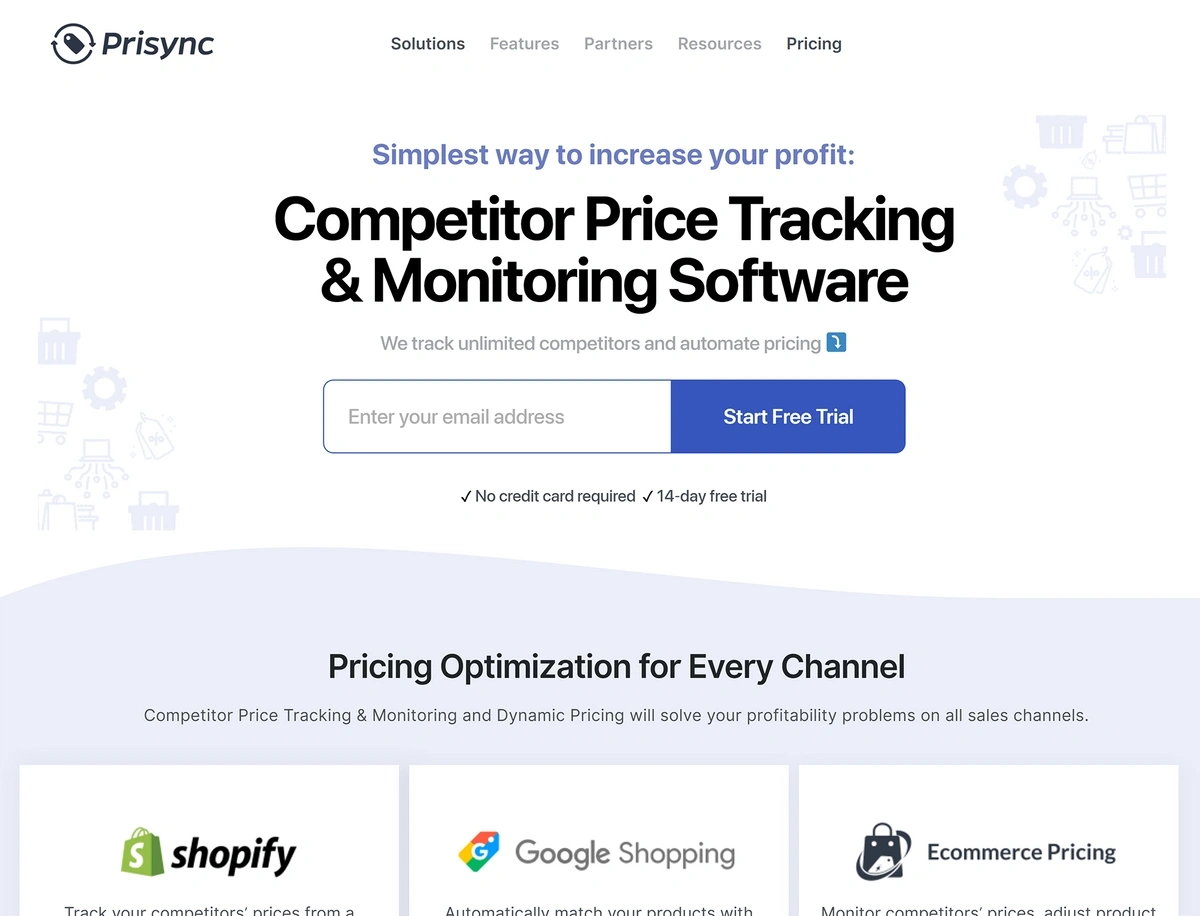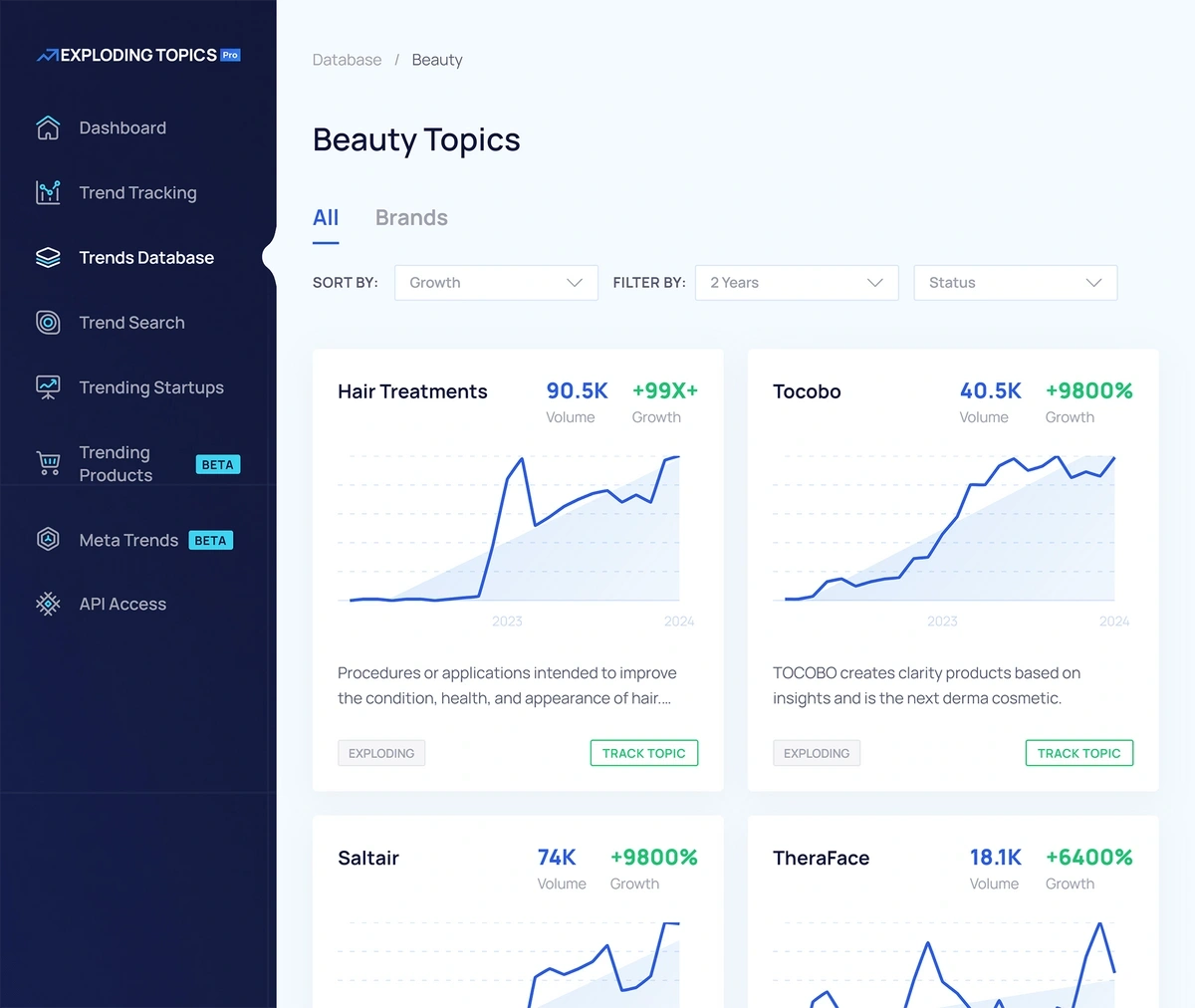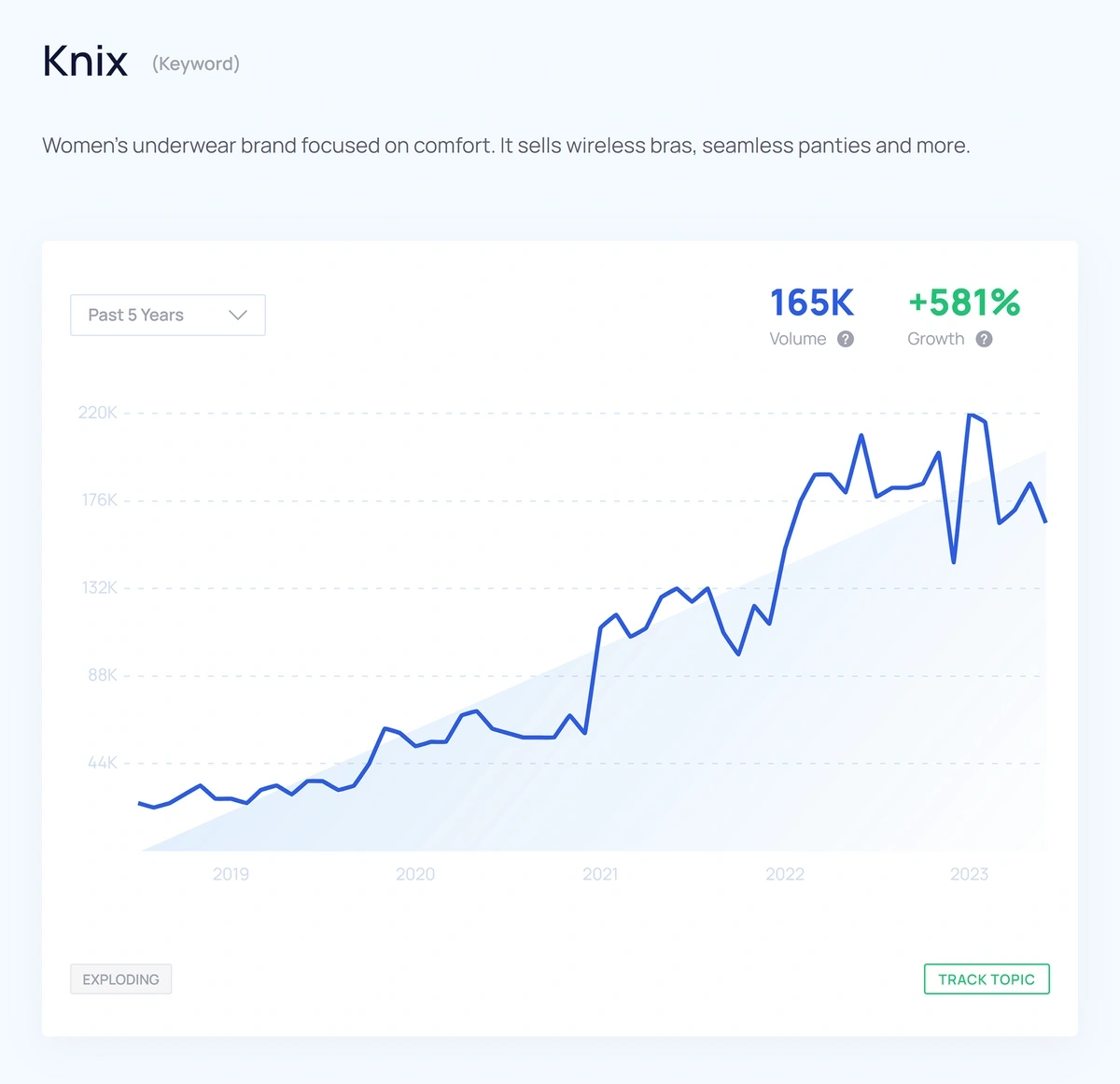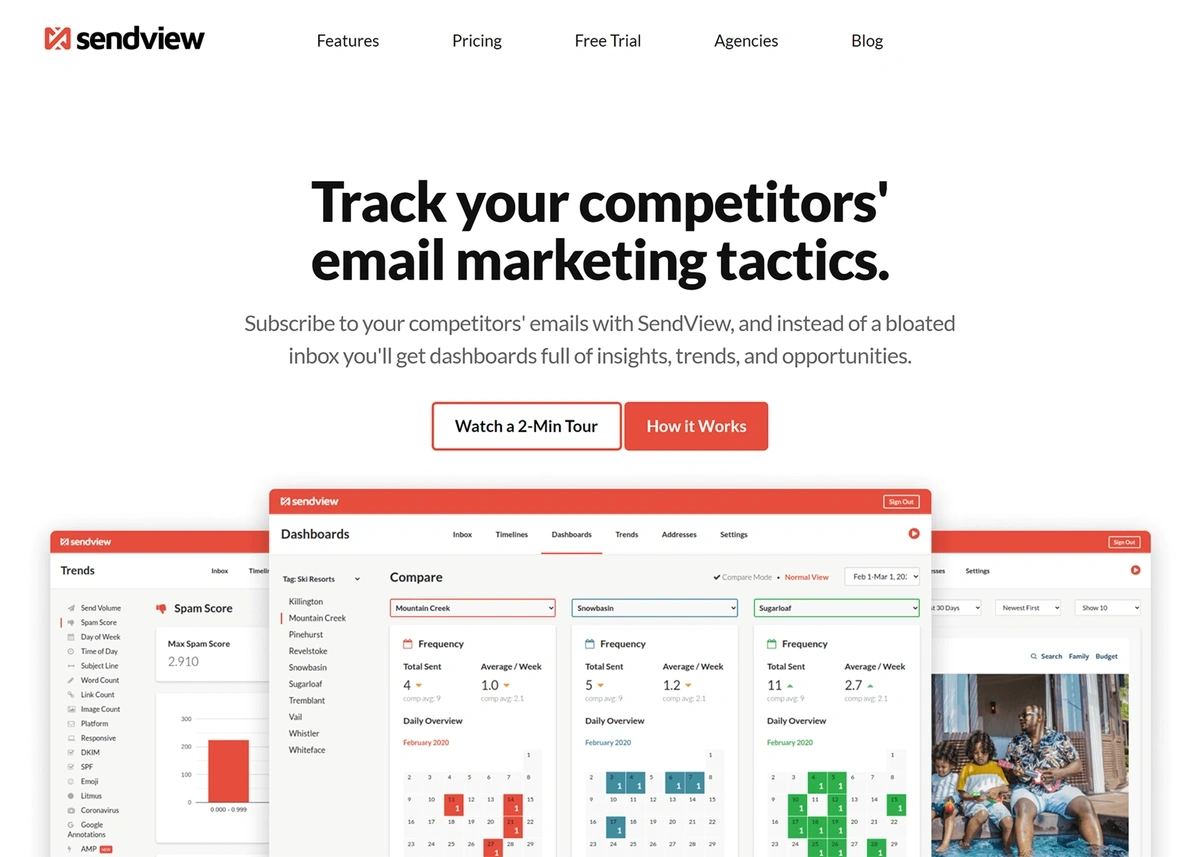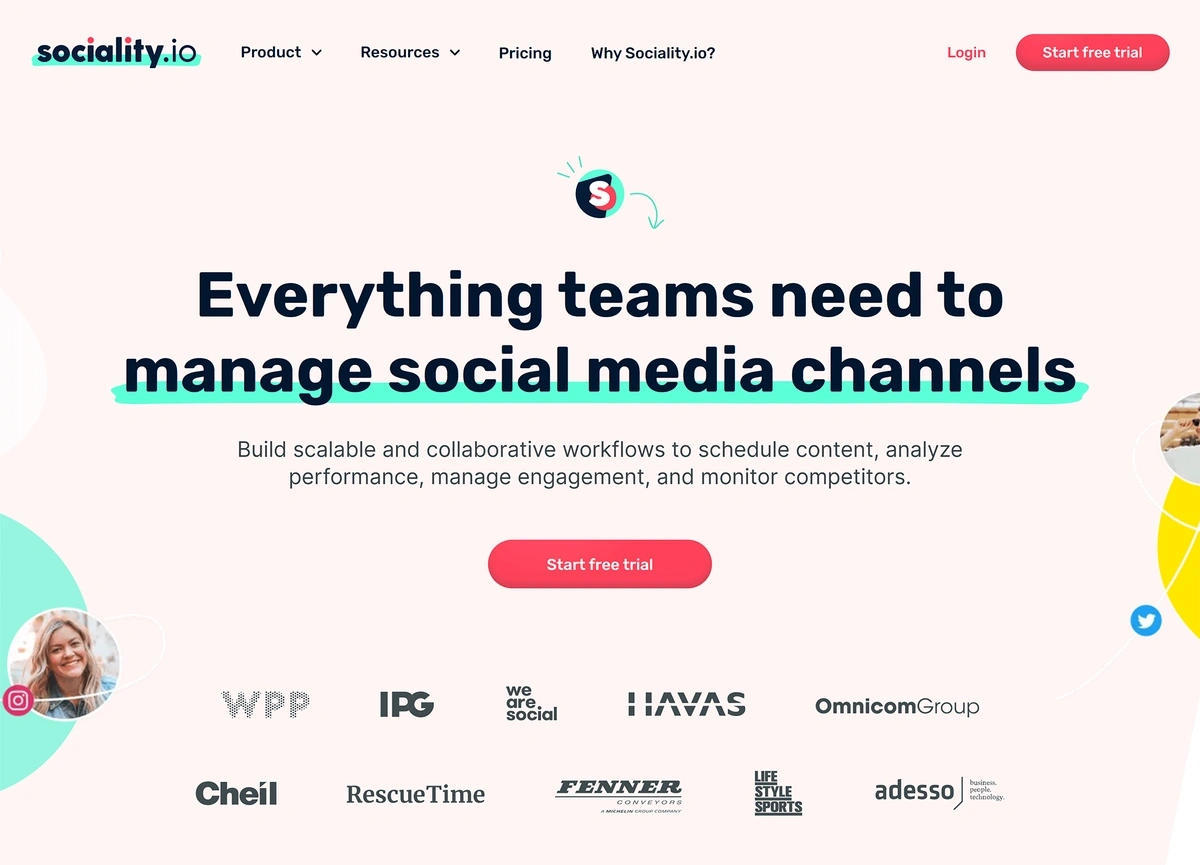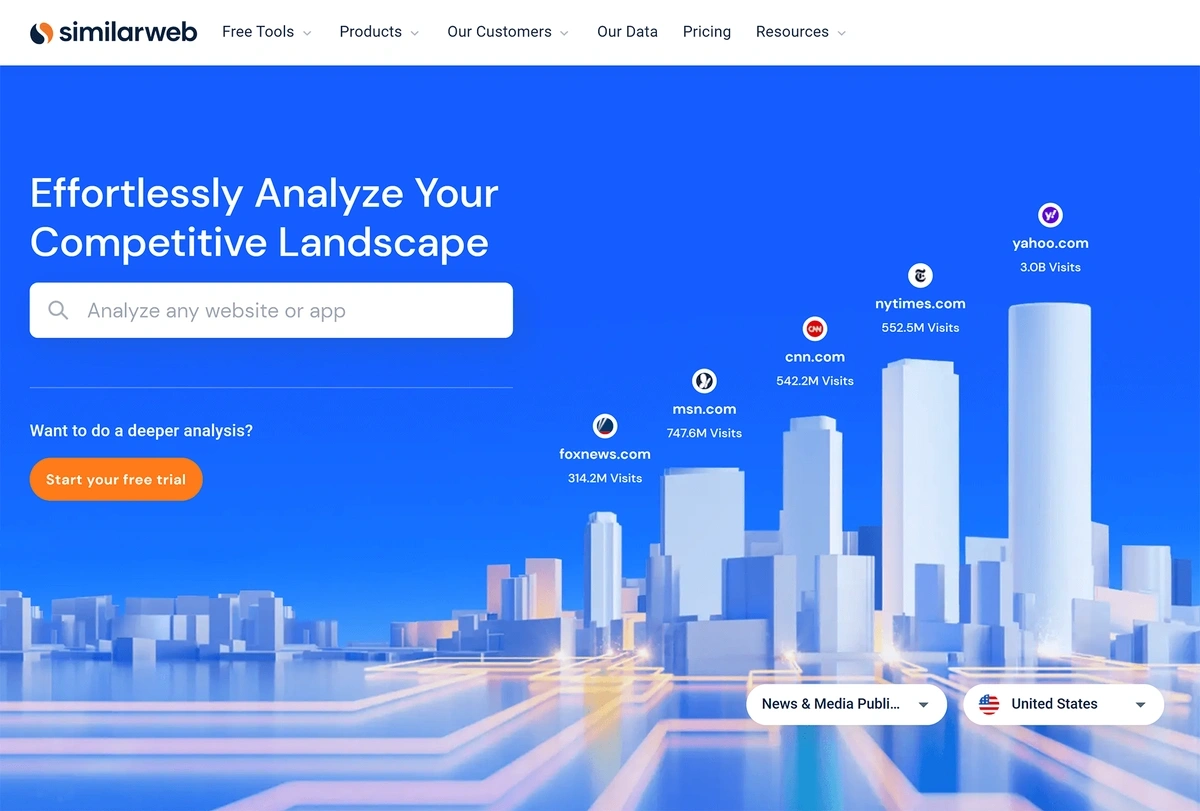
8 Top Competitor Analysis Tools (2024)
A good competitor tracking tool can allow you to uncover details about other companies' pricing strategies, ad spend, search engine results page (SERP) rankings, tech stack, and more.
Whether you're researching ideas for a new business or you want to capture more market share, the eight competitor analysis tools in this guide will help you gather the data you need.
1. Exploding Topics: Best For Analyzing Competitor Search Rankings
Exploding Topics has a free tool for conducting SEO competitor analysis.
By plugging a top competitor's domain into Exploding Topics, you'll be able to see information about their:
- Domain authority
- Total search traffic
- Clicks from organic and paid keywords
- Total keywords by ranking position
- Pay per click (PPC) Google ad copy
- Backlink profile
This data, which is powered by Semrush, can then help you with a variety of SEO and digital marketing efforts. You can potentially:
- Boost your search ranking for specific keywords
- Discover gaps in competitor content
- Develop new topics for blogs and marketing materials
- Create a content marketing strategy to outrank competitors in organic search results
- Improve your paid ad performance
- Formulate a link-building strategy
Of course, using an SEO analytics tool works best if your competitors are actively optimizing their websites for organic traffic growth.
If your biggest competitors have minimal presence in Google results and are driving most of their business through referrals or social media influencers, for example, you won’t be able to establish valuable benchmarks from SEO tools alone.
In this case, you'll want to check out some of the other competitor analysis tools on our list.
How Much Does Exploding Topics Cost?
Exploding Topics lets you run SEO competitor analysis completely free of charge.
For full access to our trend-surfacing platform, Pro plans start at $39 per month. Explore the benefits here.
2. Prisync: Best For Tracking E-Commerce Prices
Prisync is a price tracking tool that lets you monitor your competitors' pricing decisions.
With Prisync, you can:
- Track competitor prices across multiple online storefronts
- Discover new competitors in Google Shopping
- Generate reports and charts that illustrate how your prices compare to others
- Deploy dynamic pricing across your storefront
- Monitor your resellers and wholesalers for minimum advertised price (MAP) violations
The platform also integrates with Shopify, allowing you to import your inventory and quickly build lists of products to track.
You don't need to be a Shopify customer to use Prisync, though—it works across all e-commerce channels, markets, and currencies.
How Much Does Prisync Cost?
Prisync offers a 14-day free trial so you can try out the platform. After that, you'll need to pay for a plan.
Several options are available based on how you want to use Prisync.
- For $99 per month, you can track price updates on up to 100 competitor websites
- For $199 per month, you can track price changes on up to 100 products in a specific sales channel
- For $299 per month, you can track price changes on up to 100 products in a key sales channel as well as specific competitor URLs
Additional plans are available and offer increased usage limits.
3. Exploding Topics: Best For Tracking Competitor Popularity
Exploding Topics is a trend spotting tool that helps you spot when your competitors’ companies and products are growing in popularity.
We gather our trend data from multiple channels, including blogs, web pages, social networks, and news articles. You can then use this information to see:
- What topics are trending in 30+ industries
- Whether or not your competitors' products and brands are gaining in popularity
- How interest in a topic has fluctuated over time—our data goes back 15 years
- Which topics are gaining, versus dropping, in popularity
You can also see information about popular e-commerce product prices and growing startups—making Exploding Topics a very versatile tool for marketers, business owners, and investors alike.
Plus, we update our trend database every day, so you're always getting the most relevant information about products and topics related to your market.
Let's say you run a company that makes women's apparel. You'd want to know if there were new competitors entering your space—and if they had any innovative products—as soon as possible.
If you were an Exploding Topics user back in March 2021, we could've alerted you to Knix, a rapidly growing company in the women's underwear market. Just a few months later, in May 2021, the Canadian company made headlines for its $53 million Series B funding round.
Our users already knew this was a company to watch. If you only learned about their growth due to the funding announcement—or your target audience’s chatter about Knix products—it may have already been too late to make competing moves.
How Much Does Exploding Topics Cost?
There's no cost to start using Exploding Topics. You can access many of our trend graphs right from our homepage; no login required.
To take advantage of everything we have to offer—including trending product sales data, a searchable trend database, instant trend alerts, and more—you'll need to subscribe to Exploding Topics Pro.
Pro plans start at just $39 per month, billed annually, and you can start with a 14-day trial for just $1.
4. SendView: Best For Tracking Email Marketing Campaigns
SendView is a customizable competitive analysis tool for email marketers.
You use the platform to subscribe to your competitors' email blasts—which are then analyzed by SendView and displayed in a dashboard.
You can see in-depth data about your competitors':
- Email service providers
- Sending frequency, including days since last email
- Common sending days and times
- Email topics
- Email templates and design
- Links and word count per email
- Spam score
SendView also lets you favorite the competitor emails you like the best. These messages will then be saved into an inspiration board you can revisit at any time to view details about an email's design, content, and HTML.
One unique feature in SendView is the ability to test your competitors' email marketing strategy. For example, you can create multiple email aliases—then use one to sign up for newsletters and another to trigger an abandoned cart sequence.
How Much Does SendView Cost?
SendView plans start at $69 per month ($58 per month when billed annually). The company's standard plan allows you to track up to 10 competitors, and there are no limits on the number of emails you can receive, view, or save.
5. Sociality.io: Best For Tracking Competitors’ Social Media
Sociality.io is a social listening, management, and competitor monitoring tool.
If you're trying to keep tabs on what your competitors are doing on social, you can use Sociality.io to:
- View how many followers and interactions your competitors have
- Monitor other companies' monthly post frequency and per-post engagement rates
- See how steady your follower growth is compared to that of a competitor
- Discover whether your most popular competitor is posting more single images, carousels, videos, or text
- View companies' comments-to-likes ratio
- Pull lists of popular hashtags used by competitors—and she the level of engagement on posts using those tags
You can then use this information to further enhance your own social media strategy.
Sociality.io works with all of the following platforms:
- X (formerly known as Twitter)
- YouTube
This tool is a good choice for brands that do a lot of social media marketing and are in need of a new social media management tool. If your company already actively uses a service like Sprout Social or Buffer, you may find some of Sociality.io's features to be redundant.
How Much Does Sociality.io Cost?
Sociality.io plans start at $99 per month or $83 per month when billed annually. This pricing includes one user seat and the ability to track up to ten social media accounts.
To track more competitors, you'll need to purchase a business-tier plan for $199 per month ($166 per month when billed annually).
6. VidIQ: Best For Tracking Competing YouTube Channels
VidIQ allows you to easily monitor your competitors' YouTube channels.
By adding channel IDs to your VidIQ dashboard, you can monitor metrics like:
- Views per hour, day, week, and month
- All-time channel views
- Keywords associated with competing channels
- Subscriber acquisition rates and sources
VidIQ can also send you email alerts about specific trending YouTube topics. That's definitely helpful if your business has, or is growing, a YouTube channel.
If you need to track trends across multiple channels—including other social platforms or blogs—then you'll want to use a more versatile trend tracking tool like Exploding Topics.
How Much Does VidIQ Cost?
You can track up to three competitors—and get ideas for optimizing your YouTube channel—for free.
If you want to use VidIQ to monitor more channels, conduct keyword research, and directly compare competitors' content, you'll need to opt in to a paid plan starting at $7.50 per month.
7. Similarweb: Best For Tracking Audience Demographics
Similarweb is another competitive research tool that will help you learn more about other companies' websites and marketing efforts.
You can see details that include:
- Website traffic sources
- Demographic breakdowns of audience traffic
- Your competitors' main marketing channels
- Popular search trends and keywords that lead visitors to your competitors' sites
- Which social media platforms drive the most traffic to your competitors
- Tools and technologies used by your competitors
You can also compare your competitors' website to your own—or to another domain—to see how the two stack up in terms of traffic, audience, channel acquisition, and more.
The metrics provided by Similarweb can help you:
- Boost your marketing efforts on specific social media channels
- Get ideas for new plugins or tools to use on your website
- Learn more about the audience demographics in a new market
- Find new keyword opportunities
Similarweb also offers a free Chrome extension that lets you see key details about competitor websites while you browse.
How Much Does Similarweb Cost?
Similarweb has a generous free plan that lets you see a wide range of metrics about competitor sites, and compare multiple competitors, without ever signing up for an account.
To unlock all of Similarweb's data points and remove usage limits, you'll need to opt into a paid plan starting at $149 per month (or $125 per month when billed annually).
This access tier includes one user seat—if you need multiple licenses on one plan, you'll have to talk to the Similarweb team for a custom quote.
8. SimilarTech: Best For Tracking Competitors’ Customers
SimilarTech is a partner site to Similarweb, and it allows you to dig deeper into specific technologies and adoption rates.
If your company produces a software product for websites, SimilarTech will likely be a very helpful competitive intelligence tool. You can enter in the name of your competitor's company or platform and see information like:
- The total number of companies using the technology on their site
- What industries and verticals those customers tend to be in
- Other related tech companies
- What countries your competitor's product is most popular in
- Other tech platforms that your competitor is using on their website
As with Similarweb, you can compare multiple competitor products against each other—or against your own company. These insights can be helpful when you want to:
- Enter a new market
- Develop new product ideas
- Make an international expansion
- Create lists of sales prospects
SimilarTech also lets you set up recurring alerts so you get notifications when a competitor's profile changes.
How Much Does SimilarTech Cost?
Like Similarweb, SimilarTech lets you see quite a bit of data for free. To unlock more information, you can opt into a paid plan that starts at $199 per month when billed annually.
Some of SimilarTech's information overlaps with Similarweb, but it's definitely a more technology- and tool-focused competitor monitoring tool. Since both platforms offer some free access, it's a good idea to try them both out and see which one aligns more closely with your needs.
Conclusion
It’s hard for even the best competitor tracking tools to hit every one of your business and marketing needs—so it’s entirely possible that you’ll have to use more than one tool on this list to get actionable insights for marketing, business development, and more.
Try starting with a wide-reaching tool, like Exploding Topics, Similarweb or Semrush. These services will help you get a big-picture overview of your industry and the moves that competitors may be making.
From there, you can add in more specialized tools, like VidIQ or Sendview, if you need to conduct more channel-specific tracking. Ultimately, the right combination of tools will give you valuable competitive intelligence—and keep you at the forefront of your market.
Stop Guessing, Start Growing 🚀
Use real-time topic data to create content that resonates and brings results.
Exploding Topics is owned by Semrush. Our mission is to provide accurate data and expert insights on emerging trends. Unless otherwise noted, this page’s content was written by either an employee or a paid contractor of Semrush Inc.
Share
Newsletter Signup
By clicking “Subscribe” you agree to Semrush Privacy Policy and consent to Semrush using your contact data for newsletter purposes
Written By


Josh is the Co-Founder and CTO of Exploding Topics. Josh has led Exploding Topics product development from the first line of co... Read more


